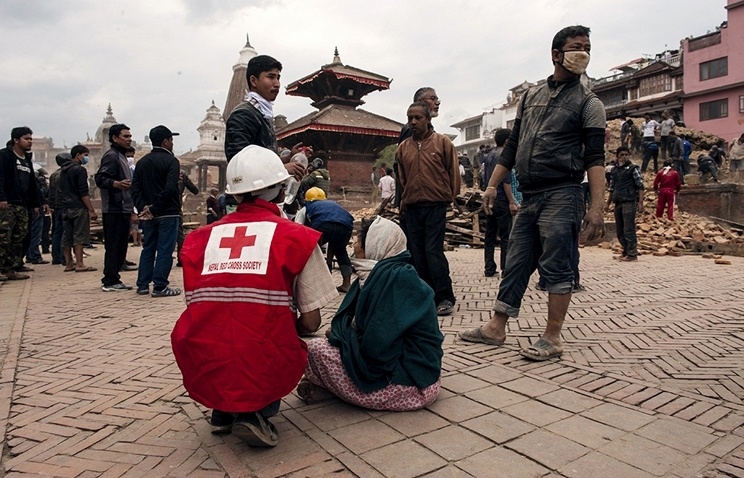Earthquake Aftershocks Jolt Nepal as Death Toll Rises Above 3,200
 10:02, 27 April 2015
10:02, 27 April 2015
YEREVAN, APRIL 27, ARMNEPRESS: Each time this city shuddered with aftershocks from the earthquake that convulsed Nepal, Samaj Gautam felt an urge to join the millions of residents who fled to safety outdoors. But working in a hospital emergency ward inundated with the wounded, and their broken limbs, fractured skulls and other physical traumas, Dr. Gautam said Sunday night, he and his colleagues had to suppress their fears and stick to treating patients, Armenpress reports, citing the New York Times.
“I’m feeling exhausted but also scared because the tremors have been by the dozens,” Dr. Gautam said as he worked through his own exhaustion in the emergency ward of Bir Hospital in Katmandu, where he had been since soon after the earthquake hit Saturday. “But the most worrying thing to me is the aftereffect. Sanitation, disease, these are also serious worries.”
By early Monday, Nepalese authorities had sharply raised the death toll to more than 3,200, but the full extent of the devastation and death was still unclear. It was that uncertainty, over what the earthquake had wrought and what the future might hold, that spread fear and anxiety across Nepal. The true extent of disasters like the one that hit Saturday often become clear only in the days and weeks afterward, as the digging-out gains momentum and crews work through the rubble of lives upended.
But for now, getting through the day — and night — is the immediate challenge as aftershock after aftershock continues to rattle this country and its unnerved people. In the capital, Katmandu, as if the powerful earthquake were not enough of a test, heavy rains pelted the thousands who sought safety in the streets, cowering under leaking tarpaulins and makeshift tents, wondering what had become of homes, lives and livelihoods thrown into limbo by the quake.
“We don’t have any place to go,” said Mohammed Kabil, one of a dozen or so men who were warming themselves near a smoky campfire as the drizzle turned to rain. They sat near the remains of the Dharahara Tower, a revered monument that was toppled by the quake.
“We don’t have any clothes, we don’t have enough food, we don’t have medicine, we don’t know when we can go back into our homes,” he said.
At the international airport in Katmandu, hundreds of frightened people tried to book flights out early Monday morning.
Sitting atop a major tectonic fault, Nepal is accustomed to the tremors of the earth. But this time it has been overwhelmed by a powerful quake that killed thousands and destroyed some of the country’s most treasured temples. Past and present were destroyed all at once, making digging out and rebuilding that much more daunting.
On Sunday afternoon, the streets of Katmandu were filled with people carrying bedrolls and pillows to any open space they could find, including a military parade ground that has been transformed into a giant tent city. Few people seemed willing to sleep inside, fearful that the next shock might make their homes pancake. There seemed arbitrariness to the destruction, one building collapsing and entombing its occupants, while another nearby withstood the shock.
That, too, added to the uncertainty, the sense that sleeping in the street, in the rain, was the only hedge against the randomness of fate.
“Everyone is scared,” said Samir Thapa, a 30-year-old security guard who, like thousands of other residents, slept in the tent city. “Everyone is saying it will come again. No one is going to sleep at home.”
As the government of Nepal struggles to gain its bearings, an international relief effort has begun to shift into gear. The United States, India and China were among countries initiating their own relief efforts, but aid officials said they were finding it difficult to get out to rural areas where some of the greatest devastation is feared.
Even getting aid and relief workers into Katmandu is complicated, with fewer than a fifth of the regular daily flights now arriving, with airlines concerned about the effects of powerful aftershocks.
The government also pleaded with its own workers to help in local rescue efforts rather than going to their usual jobs.
There is urgency to the need, knowing well how devastation can spread its roots beyond the immediate crisis. The crammed encampments, for instance, are almost certain to pose a health risk in the days ahead, Dr. Gautam said, as unsanitary conditions could allow disease to spread. “Even some patients prefer to stay in the open field because they’re afraid of being inside.”
On Mount Everest, helicopter rescue operations began Sunday morning to take wounded climbers off the mountain, where at least 18 climbers were killed and 41 others injured. At least three Americans were among the dead: Marisa Eve Girawong, a physician assistant working for Madison Mountaineering of Seattle; Dan Fredinburg, a Google engineer; and, according to Reuters, Tom Taplin, a 61-year-old filmmaker from Colorado.
Hundreds of foreign and Nepalese climbers remained trapped on the mountain, according to the news agency.
Public frustration over the hardships brought by the disaster could grow into ire with the government, if its response is seen as too little too late.
“We feel we are helpless,” said Biraj Bikram Shah, a pilot who wandered through his neighborhood darkened by a power blackout. “We can do nothing.”
He and his family slept in their garden despite the rain. Pedestrians seemed to do everything in their power to stay away from buildings. They walked in the street instead of on sidewalks.
The government announced that schools would remain closed for at least five days.
Across Katmandu, especially in the oldest districts, there are piles of detritus — timber beams and broken bricks. In the heart of the historic district, the country’s most prized temples are rubble. These buildings “are what made Katmandu special,” said Sri Kitav Sangoala, a middle-age truck driver, as he surveyed the piles of bricks that the authorities believe contain more bodies.
“So many sites are destroyed,” he said. “Our history is gone.”
In time, engineers and scientists will no doubt offer explanations for why some buildings collapsed into splinters and piles of bricks while others next door appeared indifferent to the violence of the earthquake.
But for now, there was still the overwhelming trauma of the quake. Ichcha Gauchan, a 33-year-old homemaker, said she clutched the wall of her home as everything in her kitchen flew from the shelves. She moved her hands like a metronome to describe how the houses next to hers swayed during the quake.
“I thought I had died,” she said. She is sleeping at the military parade ground, and although her house is intact, she does not plan to return home for several days. “How can we sleep at night?”
Others have no home to return to. Depak Lama, 35, a street vendor, can only stare at the pile of bricks that used to be his home. Under the rubble are his savings, his identity card, his mobile phone, clothing and all of his family documents.
In the seconds before the earthquake struck, Mr. Lama said, it felt as if it suddenly became very windy outside. Birds flew away in frenzy. He grabbed his 2-year-old son and ran from the building as bricks fell on his head. On Sunday, among the dusty piles of debris that were once his home, were a pair of socks, pages of a book and a padlock.
Dr. Gautam, 30, said he had rushed into work at the emergency ward of Bir Hospital soon after the earthquake struck. The ward and a unit for less serious injuries had treated about 1,000 people over the weekend, far more than the 15 or 20 people they receive on an average weekend.
Although the hospital is one of Katmandu’s best-regarded government hospitals, its relatively primitive equipment and medical supplies were no match for the influx of patients with broken limbs, punctured chests and other injuries.
“The casualties from the buildings will still grow,” he said, “not so fast, but the other problems will grow.”





















